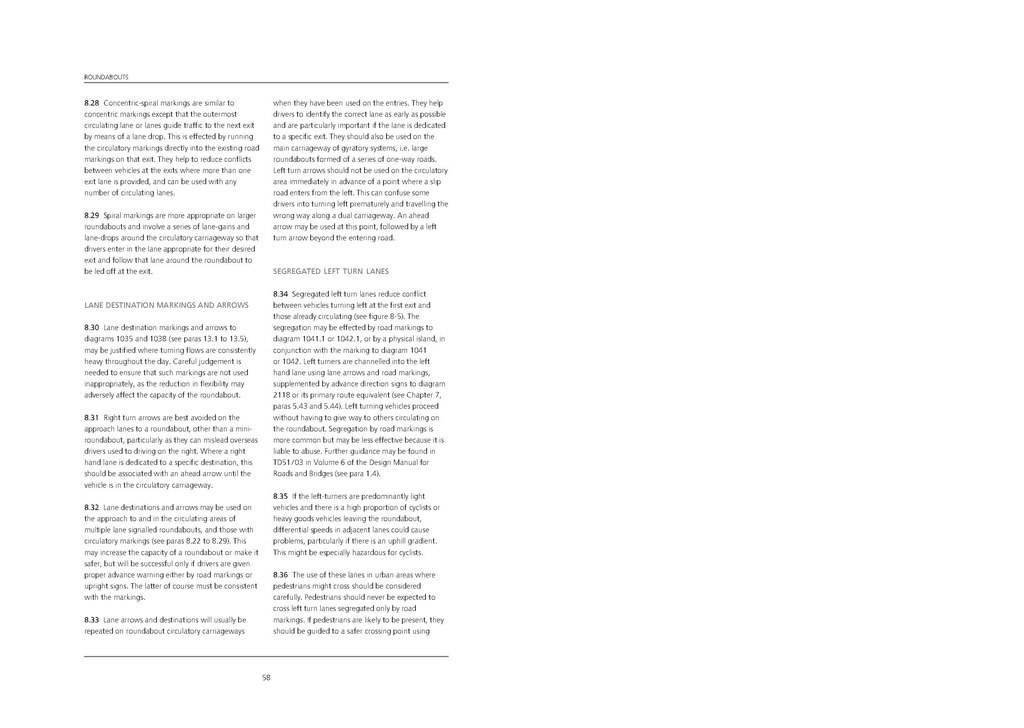8.28 Concentric-spiral markings are similar to concentric markings except that the outermost circulating lane or lanes guide traffic to the next exit by means of a lane drop. This is effected by running the circulatory markings directly into the existing road markings on that exit. They help to reduce conflicts between vehicles at the exits where more than one exit lane is provided, and can be used with any number of circulating lanes.
8.29 Spiral markings are more appropriate on larger roundabouts and involve a series of lane-gains and lane-drops around the circulatory carriageway so that drivers enter in the lane appropriate for their desired exit and follow that lane around the roundabout to be led off at the exit.
LANE DESTINATION MARKINGS AND ARROWS
8.30 Lane destination markings and arrows to diagrams 1035 and 1038 (see paras 13.1 to 13.5), may be justified where turning flows are consistently heavy throughout the day. Careful judgement is needed to ensure that such markings are not used inappropriately, as the reduction in flexibility may adversely affect the capacity of the roundabout.
8.31 Right turn arrows are best avoided on the approach lanes to a roundabout, other than a mini-roundabout, particularly as they can mislead overseas drivers used to driving on the right. Where a right hand lane is dedicated to a specific destination, this should be associated with an ahead arrow until the vehicle is in the circulatory carriageway.
8.32 Lane destinations and arrows may be used on the approach to and in the circulating areas of multiple lane signalled roundabouts, and those with circulatory markings (see paras 8.22 to 8.29). This may increase the capacity of a roundabout or make it safer, but will be successful only if drivers are given proper advance warning either by road markings or upright signs. The latter of course must be consistent with the markings.
8.33 Lane arrows and destinations will usually be repeated on roundabout circulatory carriageways when they have been used on the entries. They help drivers to identify the correct lane as early as possible and are particularly important if the lane is dedicated to a specific exit. They should also be used on the main carriageway of gyratory systems, i.e. large roundabouts formed of a series of one-way roads. Left turn arrows should not be used on the circulatory area immediately in advance of a point where a slip road enters from the left. This can confuse some drivers into turning left prematurely and travelling the wrong way along a dual carriageway. An ahead arrow may be used at this point, followed by a left turn arrow beyond the entering road.
SEGREGATED LEFT TURN LANES
8.34 Segregated left turn lanes reduce conflict between vehicles turning left at the first exit and those already circulating (see figure 8-5). The segregation may be effected by road markings to diagram 1041.1 or 1042.1, or by a physical island, in conjunction with the marking to diagram 1041 or 1042. Left turners are channelled into the left hand lane using lane arrows and road markings, supplemented by advance direction signs to diagram 2118 or its primary route equivalent (see Chapter 7, paras 5.43 and 5.44). Left turning vehicles proceed without having to give way to others circulating on the roundabout. Segregation by road markings is more common but may be less effective because it is liable to abuse. Further guidance may be found in TD51 / 03 in Volume 6 of the Design Manual for Roads and Bridges (see para 1.4).
8.35 If the left-turners are predominantly light vehicles and there is a high proportion of cyclists or heavy goods vehicles leaving the roundabout, differential speeds in adjacent lanes could cause problems, particularly if there is an uphill gradient. This might be especially hazardous for cyclists.
8.36 The use of these lanes in urban areas where pedestrians might cross should be considered carefully. Pedestrians should never be expected to cross left turn lanes segregated only by road markings. If pedestrians are likely to be present, they should be guided to a safer crossing point using
58
